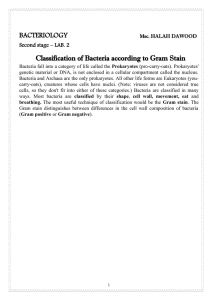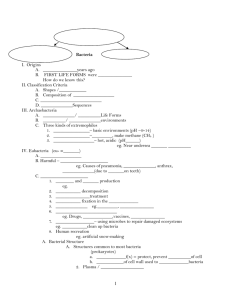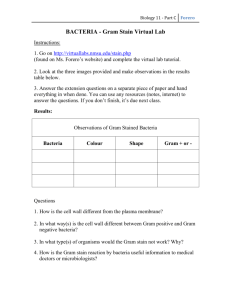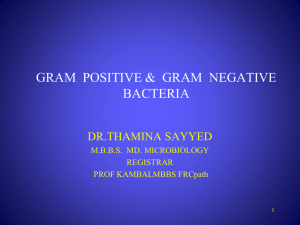Introduction to Microbiology H. GEE. MD, FRCOG Hon. Assoc. Clinical Professor
advertisement
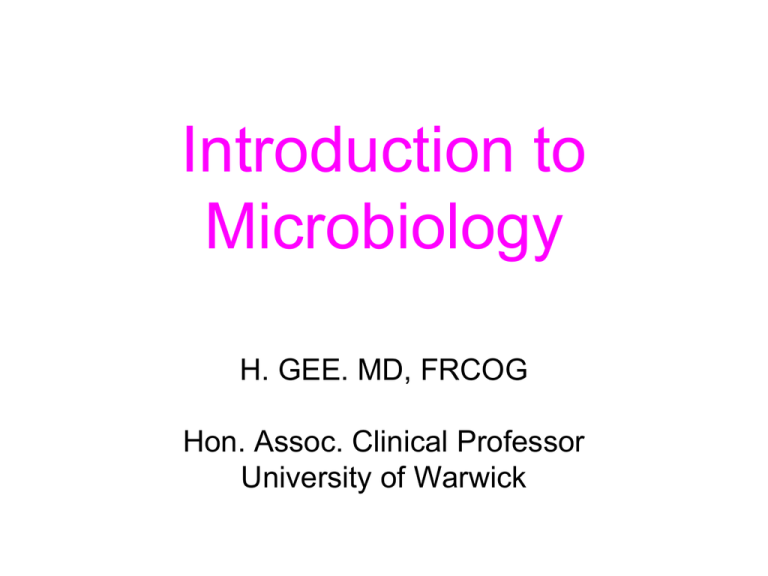
Introduction to Microbiology H. GEE. MD, FRCOG Hon. Assoc. Clinical Professor University of Warwick Peter Gayo Munthali Consultant Microbiologist UHCW What is Microbiology • The study of micro-organisms – Bacteria (Bacteriology) – Viruses (Virology) – Parasites (Parasitology) – Fungi (Mycology) • Human, Animals, Plants Aim To introduce general principles in microbiology with an emphasis on bacteria and viruses Objectives • By the end of the session you should be able to; – Distinguish between gram-positive and gramnegative bacteria – Describe bacteria by their shape as either cocci or rods – Name some common bacterial and viral diseases linked to their causative organisms – Describe in broad terms, how antibiotics work on bacteria – Describe the difference between bacteria and viruses. Some definitions Infection ‘the establishment of a microorganism within a host’ Pathogen ‘any microorganism that has the capacity to cause disease’ Virulence ‘ quantitative measure of the likelihood of causing disease’ Opportunistic • Principle pathogens regularly cause disease • Opportunistic pathogens require a defect in the immune defence – Eg Pseudomonas Bacteria Bacteria Description • Unicellular • Prokaryotic – Primitive nucleus • No nucleus membrane • Genome • Single circular molecule double stranded DNA • Can harbour independent small circular DNA molecules called plasmids • Structure • Rigid wall which determines their shape Prokaryote Eukaryote Prokaryote vs Eukaryote Overall structure of bacterial cell walls Gram –ve cell wall Gram +ve cell wall Bacteria Classification • Cell wall classification by gram stain • Gram positive – thicker cell wall • Gram negative – thinner cell wall • Classification by shape – Spherical • Cocci – Cylindrical • Rods/bacilli Gram-Positives Gram Stain Gram-positive cocci in clusters (Staphylococci) Gram-negatives Gram-negative rods Gram-positive rods Gram-positive Cocci in chains (Streptococci) Gram-negative cocci Gram Stain - Importance • First stage of identification – (Culture) • Indicator for treatment – (Sensitivity) Gram Stain • +ve cocci, clustered • +ve cocci, paired or chains • +ve bacilli (large + spores) • -ve cocci (intra-cellular) • -ve rods, coliform • -ve rods S. Aureus (coag -ve) Strep. Enterococci Clostridium Gonorrhoea E. Coli/Coliforms Pseudomonas Anaerobes Haemophilus spp Culture & Sensitivity • Culture – Aerobic/Anaerobic – Haemolytic – Others (type of media) • Sensitivity – Antibiotics Bacterial Cell Division Super coiled DNA DNA relaxation and duplication Duplication of the DNA Enzymatic Cleavage bacterial chromosome replicates leading to two identical chromosomes Division Identical Daughter cells Genetic variability Lateral gene transfer Virulence ‘ quantitative measure of pathogenicity or the likelihood of causing disease’ Virulence factors 1. Aid colonisation 1. Adhesion proteins 2. Entry into cells 2. Aid survival 1. Immune avoidance eg. antiphagocytic 2. Immunosuppression 3. Damage host 1. Toxins 4. Obtain nutrition from host Obligatory steps for infection Attachment +/- Evade natural protection and cleansing mechanisms Entry into body Local or general spread Evade immediate local defences Multiplication Evasion of host defences Evade immune and other defences for growth in the host to be completed Shedding from body Leave body at a site and on a scale that ensures spread to fresh host- transmission Relationship with humans • We are sterile in utero • Shortly after birth colonised • Of 100000000 bacterial only 1000 are successful – Suggests highly evolved Microbiome Vaginal Flora • Lactobacilli (Gram -ve) • Gram +ve – – Atopobium spp. Peptostrep. spp. – Staph. Spp. – Strep. Spp. – Bacteroides – Fusobacterium spp. – Gardnerella Vaginalis – – Mobiluncus Prenotella spp. • Gram -ve –E. Coli • Others – Candida albicans – Mycoplasma – Ureaplasma Biofilms Any Questions? Size Matters 1nm 10nm 100nm 1 µm 10 µm 100µm 1mm Light microscope Electron Microscope Proteins Viruses Small molecules Plant and animal cells Bacteria Bacteria Classification Bacteria and Human body • Bacteria >10x than human cells in the body (10¹ versus 10¹³) – Skin surface and in deep layers – Saliva and oral mucosa – Gastrointestinal tracts – Genital tract • Normal microbiota or microflora – Beneficial to human health – Opportunistic infections • < 10% culturable • Others not part of normal microbiota – Pathogenic – Opportunistic pathogens


